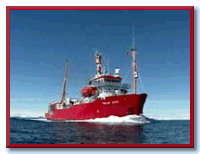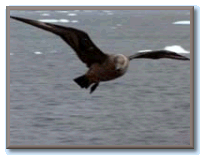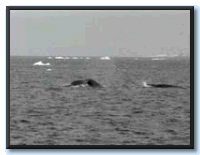|
From: Mary Lenox, Palmer Station Mary Lenox (who'll give us a tour of Palmer during LFA 2 program 2) tells what has to happen when there's a serious medical emergency, and describes some of the inspiring natural history sights to be seen around Palmer. "Medical Evac Occurs at Palmer Station"
What happens when someone needs to get out in a hurry? Read on...
The R/V POLAR DUKE arrived on schedule at Palmer Station at 08:00 local time on 11 November with the usual chaos of cargo and new personnel. Orientation was presented to the new folks and mail was delivered, contributing to the festive atmosphere. Yet in addition to the usual excitement, there was a undescribable tension in the air. Later in the morning, a fragile young woman shuffled around often escorted by the physician. She wasn't moving onto station, for she was a part of the science group scheduled to cruise the high seas for the next month. She was diagnosed and had suspected acute appendicitis and with that the station crew jumped into high gear. After conferring with the NSF Rep at McMurdo, Rothera BAS, a British base located a couple of hours by Twin Otter plane from Palmer, was contacted and without hesitation, Rothera responded to our MEDEVAC needs. Plans were formalized for a Twin Otter to land that evening. At that point, a few members of the GSAR team headed up on the glacier to map out a landing area. The largest snow field was surveyed and the appropriate gear secured: bamboo poles, flags, and a hand saw. Once back on the glacier, existing walking trails were surveyed and guide flags were cut off below the snow surface and aircraft guide flags were posted. A make-shift wind sock was placed at the top of the glacial runway along with a couple of flags establishing the beginning of the approach. Every hundred meters, more flags were pitched continuing down the hill and ending approximately 200 meters above the antenna where black and orange flags indicated the end of the safe zone. At that point, if the plane wasn't wasn't stopped, it had to prepare to return to the air. After flagging the runway, the GSAR team members involved returned to assist in preparing the patient and one of our community members to depart with her. Tim Cully, an OAE and registered nurse, was deployed as medic, as the Brits could not assume liability for the patient without medical assistance from us. So Mr. Cully took off on another adventure, passport in hand, not to return due to the ship's schedule until the end of December. Having been a field instructor at McMurdo, he'll spend the next six weeks in Punta Arenas working in the warehouse with the field gear. An entourage from Station waited at the top of the glacier for the Twin Otter. The plane circled the area while a sudden snow squall moved through the area. Once the weather cleared, the plane landed short and hard. (It's suspected that the pilot mumbled something about flat light as he stepped out onto the glacier!) Within minutes the patient, riding comfortably on a Nansen sled behind a snowmobile, arrived and was loaded into the Twin Otter. She maintained her sense of humor throughout the day, claiming to be "precious cargo" and was handled appropriately. It was a very short visit and within minutes, patient, medic and crew returned to the air. All they left behind was three ski tracks in the snow of the glacier. Once at Rothera, they swapped planes, and took off for Punta Arenas, Chile. They arrived in PA at 03:30 and after verifying her condition, the patient was in surgery by 15:30 that afternoon. Last we heard she and her medical companion, Mr. Cully, were seeing the area sights and she was seeking short-term employment in the area affording her the opportunity to wait out the return of the DUKE and her scientific comrades. Needless to say, she is recovering without complication. Without the assistance of Rothera BAS and their aircraft assets, the patient would have faced a potentially perilous, four-day Drake crossing. Their cooperation was greatly appreciated by everyone involved, especially the patient and her science group who were able to maintain their cruise schedule. Their science appears to have continued unhindered. *** Light, Life and Death on "The Ice" Last Monday evening was glorious and Gumby and I took full advantage of the sunshine and headed by Zodiac to Old Palmer (OP). The ice cave is there and with the sunshine we were hoping to enjoy the eerie light that penetrates the ice. We weren't disappointed. The entrance to the cave was quite tight still even though there is a torrent of melt water rushing from the orifice. I had slipped out of my float suit over at the boat landing fairly confident that I would be warm enough running around in a couple of layers of long underwear and a fleece jacket. (I was comfortable and probably amusing to look at.) So we crept in on our hands and knees through the opening, back over the mound of snow some 30 feet deep before the snow shelf ended and the cave as we knew it last Fall, opened up. It was quite dark with the snow covering the opening. The darkness set off the areas where the snow had thinned on top which allowed the sunlight to hit the ice. The intense blue light draws you to it... it is the only thing you can see until you turn away from it and allow your eyes to become accustomed to the darkness. The noise is intense as well, for there is a three foot wide river running down the middle of the floor of the cave with ice shelves on either side. You feel as though you are in your own little 8 x 20' x as far as you could see. It would be an inspiring place to sit and ponder the wonders of the world if you were dressed for its cool dankness. I needed to keep moving. The cave continues about a hundred meters. At one point it splits into two sections and then opens into a cavernous galley. A bit further up it turns and cuts off most of the available light making for a few minutes of foot sliding so as to not slip unwittingly into the babbling brook or into some other unknown obstacle. Eventually you near the end and the light seeps in to make the path clear. Again on hands and knees, we crawled up a snowy incline to daylight. By March, you'll be able to walk right out to the skua pond.
The skua pond is about an acre or so and sits at the base of a great glacier wall that must run 100 to 125 feet high. It would be a great spot to ice climb, but I've not gotten over there to do so. Hmm. A Fall activity for sure. In the skua pond there were huge chunks of ice, but when you jostled them, ice shards would detach from the whole. The shards were skinny icicles about 6 inches long. It was quite cool and of course, I got a photo of that, too. There were even skuas sitting on one of the pieces of ice. How fitting, eh? On the way home from OP, we passed an ice floe with three crabeater seals on it. Greg, our companion for the evening, filmed them with their "pillow drool" as they stirred from their sleep to greet us, and then off we went. (I had just finished off a roll and in an attempt to keep the camera free for Johan to use the next day, I didn't reload.) When we reached home a couple of minutes later, I decided that it would be worth yet another roll of film so we turned around and flew across the water to the floe. I quickly shot off the roll because these beautifully-furred, docile creatures were quite curious and gave us a great opportunity to capture their sleepy faces. What a night of fabulous sights! Sunday started off slowly, but by early afternoon we were at full speed and heading for the trolley to hike to the end of Bonaparte Point. (Ed. note: Virtual visitors will do the same via video during LFA 2 program 2!) The sun was out and whales had been sighted in the area so we were hopeful. I was armed with only my binoculars, since Gumby claims we see more cool stuff when I don't have my camera. Johan, our brainy science tech friend, heard the radio traffic and wandered down to join us at the trolley. In his nearly two years on station, he had never crossed the inlet by trolley. (We were easy on him with two of us pulling!) Once across, and what a quick trip it was with the two of them pulling me, we ditched our mutual float coat among the rocks and rock hopped south. There aren't many skuas on Bon this year. Apparently, they aren't having a very successful reproductive season so they aren't protecting nests and therefore, aren't dive bombing visitors. Anyway, the tide was low and we crossed the narrows easily. It was not long once we reached the end of the Point that we realized we were in for a great afternoon.
A humpback was spotted between us and Torgersen Island, which is only a thousand meters off. We perched amongst the sun-warmed rocks and watched. The krill must have been thick off Torgy because this whale made pass after pass along the coast of the island. He or she would even fluke every couple of passes and would then disappear for a number of minutes afterward. I was ecstatic to see the flukes. What a treat. Gumby spotted a couple of other humpbacks off about a mile or so out just east of Janice Island. Then I wasn't sure which direction to watch. Gum exclaimed, "They're breaching" and in my excitement, thinking my binocs were secure around my neck, I flung them away from my face so as to put on my glasses, and "kurplunk" the binocs landed in a small puddle next to me. I managed to get my glasses on, spot the lunge-feeding whale and laugh myself silly at the excitement of it all. Wow! What a day! Along with the whales, within a few short hours, we also watched a number of porpoising penguins, penguins attempting to land in heavy surge and bouncing off the rocks on which they were trying to land, g.p.s (giant petrels), skuas, kelp gulls, Wilson Storm petrels, and a leopard seal devouring his lunch, a penguin. When a leopard seal grabs a penguin, it whips is back and forth on the top of the water to skin the carcass. It is quite a sight and you aren't quite sure if it's playing with its food or there is some purpose to the show. The gulls and the Willies in the area swoop in and grab the bits and pieces that are flung away and all that is left is the feathered skin of the bird. It was an incredible sight... the end of one life and the means to continue many others. |
|||||||
| Back to Field Journals Menu | Mary Lenox's Journals | ||||||
![]()


